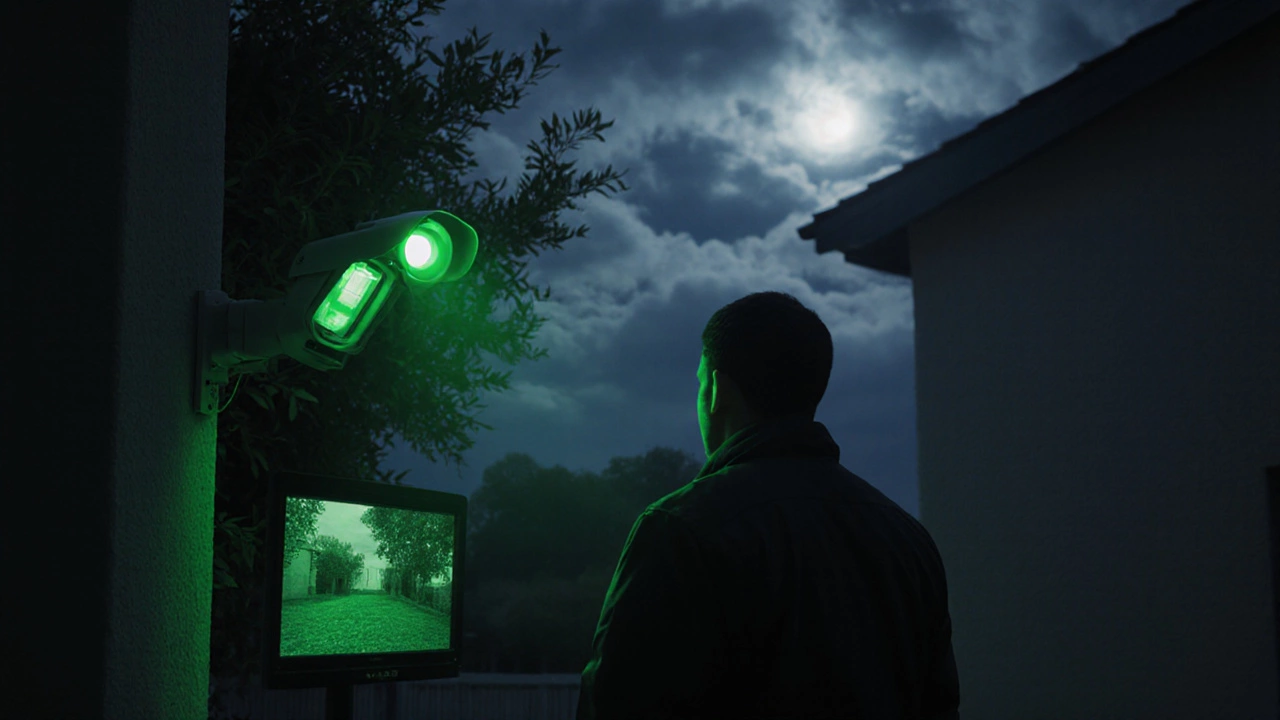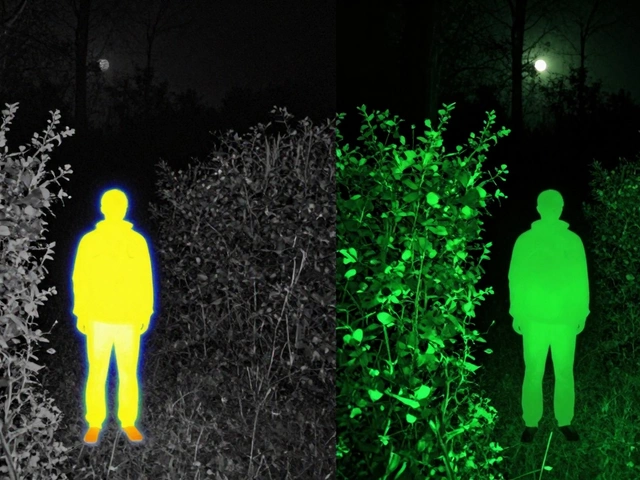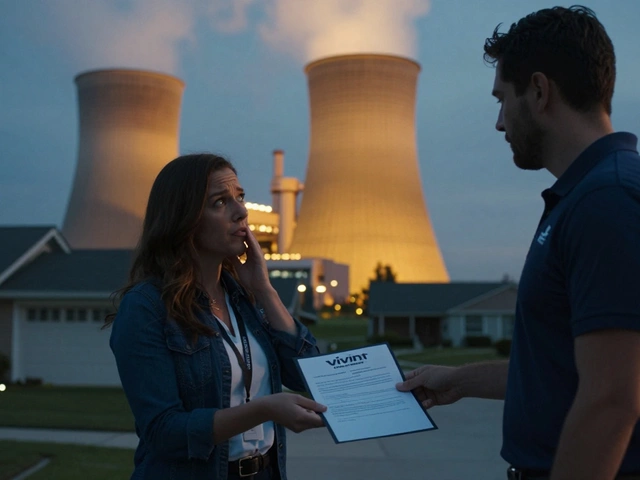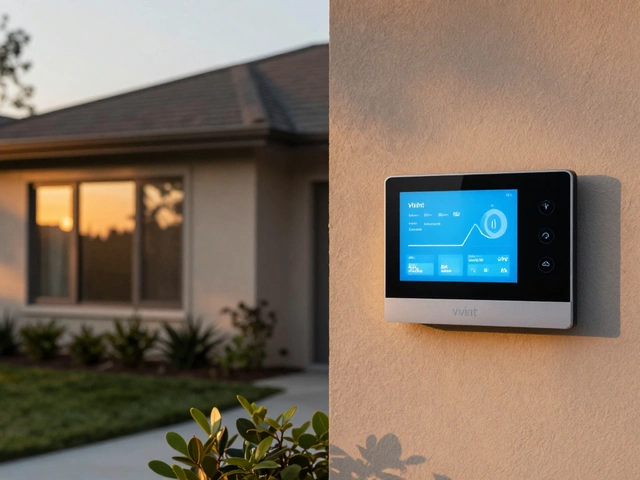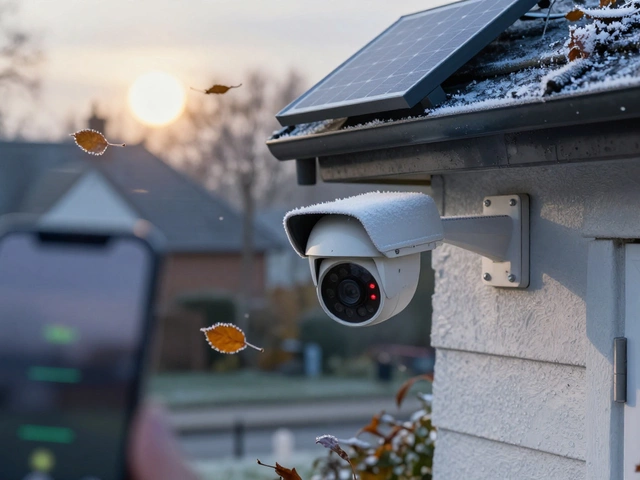Security Camera Technology Selector
Choose Your Requirements
Recommended Technology
Ever wondered what can outshine traditional night vision in a security camera? You’re not alone. Night vision has been the go‑to for dark‑time monitoring for years, but newer tech is rewriting the rulebook. In this guide we’ll break down why night vision sometimes falls short, compare the hottest alternatives, and help you pick the right eye for your watch‑tower.
What a Night Vision Camera Actually Does
When most people say “night vision,” they picture a green‑tinted glow. That glow comes from Night vision camera a device that amplifies available light, often using an image intensifier tube, to produce a visible picture in near‑dark conditions. The sensor boosts whatever photons are around-moonlight, starlight, or street lamps-into a brighter image.
- Works best when there’s at least some ambient light.
- Typical range: 30‑80 m depending on tube quality.
- Image appears green because the phosphor screen is tuned for that hue.
Sounds solid, right? Not always. Let’s see where it trips.
Why Night Vision Isn’t Always Enough
First, the world isn’t always illuminated. Cloudy nights, dense foliage, or indoor settings can leave a night‑vision camera staring at a grainy gray. Second, image‑intensifier tubes age-gain drops, and color fidelity vanishes. Finally, the green tint makes it harder to spot subtle details like a red‑shirt intruder or a fire’s orange flare.
Because of these limits, security pros have started asking: what’s better than night vision? The answer lies in three newer families.
Infrared Cameras: The Classic Upgrade
Infrared (IR) cameras add built‑in IR LEDs that emit invisible light and then capture it with a standard sensor. Here’s the first definition you’ll see:
Infrared camera a camera equipped with IR LEDs that illuminate a scene with infrared light, allowing the sensor to render a clear black‑and‑white image in total darknessKey benefits:
- No green tint-pure black‑and‑white contrast makes motion easier to spot.
- Ranges up to 150 m with high‑power LEDs.
- Works indoors and outdoors, regardless of ambient light.
Drawbacks?
- IR LEDs can be spotted if an intruder knows what to look for.
- Power consumption rises with longer ranges.
Thermal Imaging: The Real Game‑Changer
If you need to see through fog, smoke, or complete darkness, thermal imaging wins hands‑down. Meet the second central player:
Thermal imaging camera a sensor that detects infrared radiation emitted by objects, converting temperature differences into a visual picture without any external illuminationWhy it matters:
- Detects heat signatures, so a person is visible even behind foliage or in total blackout.
- Resistant to glare, headlights, and laser pointers.
- Typical detection range: 200‑300 m for civilian models, up to 600 m for professional units.
Thermal does cost more-usually three to five times a high‑end IR camera-but prices have dropped. In 2024, a 640×480 thermal sensor sat at around £350, making it viable for mid‑size homes.
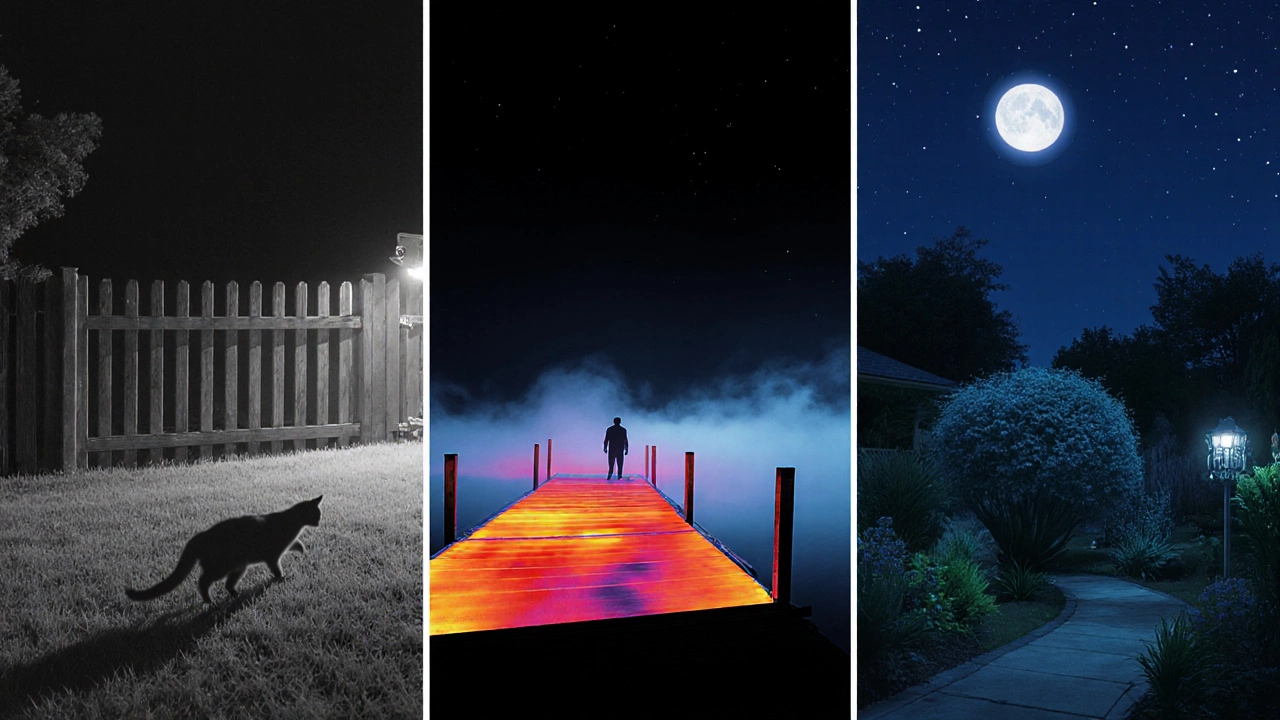
Starlight & Low‑Light CMOS Sensors: The Quiet Contenders
Modern CMOS chips can amplify tiny amounts of light without the green glow of an intensifier. These are often marketed as “starlight” sensors. First mention of the tech:
Starlight sensor a highly sensitive CMOS sensor that uses advanced denoising algorithms to render color images in environments with as little as 0.001 lux of lightWhat you get:
- Full‑color night footage-great for facial recognition.
- Ranges of 40‑60 m in moonless conditions.
- Lower power draw than IR LEDs.
They’re not as long‑range as thermal, but they fill the sweet spot between image quality and cost.
Other Emerging Techs to Keep on Your Radar
While IR, thermal, and starlight dominate today’s market, a few niche ideas are worth watching:
- Radar‑based motion detection: Uses millimeter‑wave radar to sense movement through walls and foliage.
- LiDAR depth mapping: Adds a 3‑D point cloud to help AI distinguish a person from a swaying branch.
- AI‑powered analytics: Real‑time heat‑signature classification, false‑alert reduction, and automatic zoom.
These add layers of intelligence rather than raw visual capability, but together they shape the next generation of security cameras.
Comparison Table: Night Vision vs. Infrared vs. Thermal vs. Starlight
| Feature | Night Vision | Infrared | Thermal Imaging | Starlight Sensor |
|---|---|---|---|---|
| Light source needed | Ambient only | IR LEDs built‑in | None - detects heat | Ambient (very low) |
| Typical range (m) | 30‑80 | 80‑150 | 200‑300 (civilian) | 40‑60 |
| Image colour | Green‑tinted | Black‑and‑white | Grey‑scale (thermal palette) | Full colour |
| Performance in fog/smoke | Poor | Limited | Excellent | Moderate |
| Power consumption | Low | Medium (LEDs) | High (sensor & processing) | Low‑Medium |
| Typical cost (USD) | $80‑150 | $120‑250 | $350‑900 | $200‑400 |
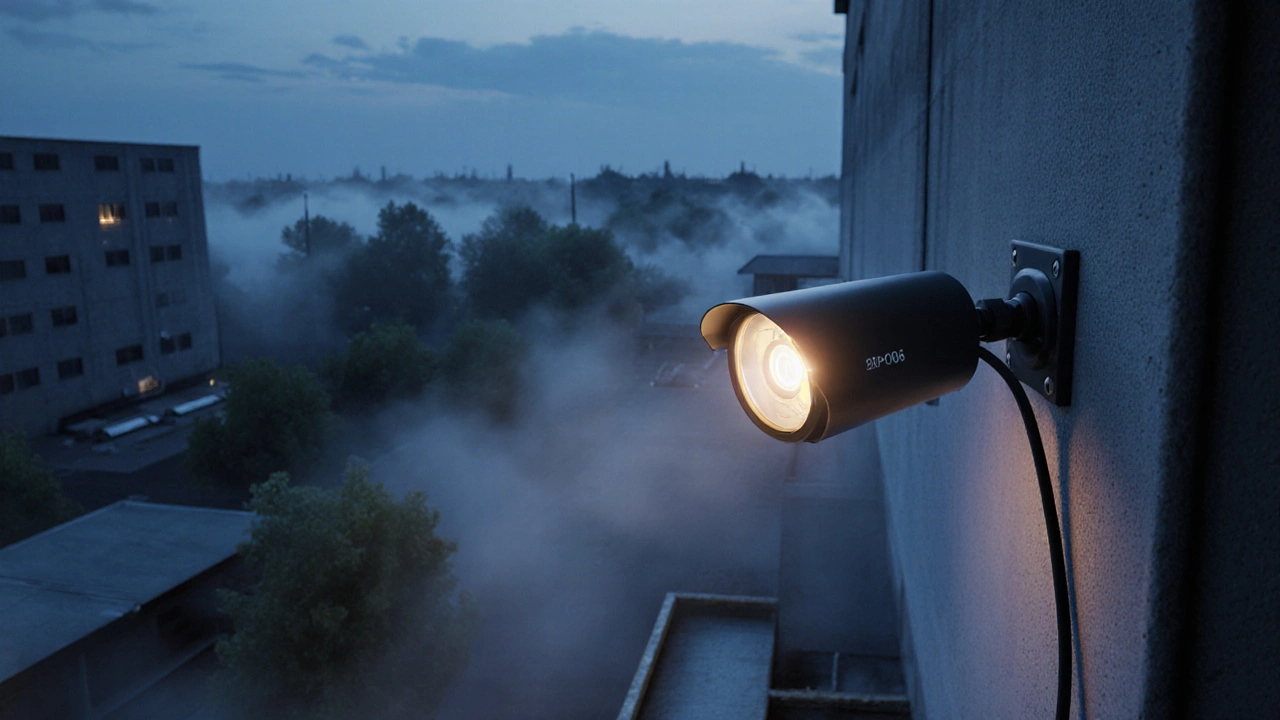
How to Choose the Right Eye for Your Situation
- Assess the environment. Is your camera watching a fenced yard, a dark garage, or a fog‑prone dock?
- Define the required range. For a driveway, 80 m IR may be enough; for a warehouse perimeter, thermal is safer.
- Consider power availability. Battery‑run setups benefit from low‑draw starlight or night‑vision models.
- Budget constraints. Allocate roughly 30 % of your total security spend to the sensor; the rest goes to storage, mounting, and AI.
- Future‑proofing. Pick a camera that supports firmware updates and integrates with popular smart home hubs (e.g., Home Assistant, Alexa).
Following this checklist often leads to a clear winner without over‑spending.
Installation Tips & Common Pitfalls
Even the best sensor can underperform if mounted wrong.
- Angle matters. For IR, avoid pointing LEDs directly at reflective surfaces; a 30° tilt reduces glare.
- Clear line‑of‑sight. Thermal cameras see heat through thin foliage but struggle with dense walls. Map obstacles before drilling.
- Weatherproofing. Choose enclosures with an IP66 rating for rain and dust; thermal lenses can fog if not sealed.
- Power wiring. Use a PoE injector for stable voltage; voltage drop over long runs can dim IR LEDs.
Double‑check connections, run a quick night‑time test, and you’ll avoid the classic “camera works in daylight, fails at night” trap.
Quick Decision Cheat Sheet
| Best for low budget & short range | Night Vision or basic IR |
| Best for colour detail in darkness | Starlight sensor |
| Best for all‑weather, long range | Thermal imaging |
| Best for AI‑driven alerts | Any sensor with built‑in AI + good illumination (IR or Thermal) |
Next Steps & Troubleshooting
After you pick a camera, here’s what to do:
- Configure motion zones. Limit detection to high‑traffic areas to cut false alarms.
- Set storage. For 30‑day retention, a 2 TB NAS with H.265 compression is usually enough.
- Test in real conditions. Run the system on a cloudy night, then at dawn. Adjust gain or IR intensity as needed.
- Update firmware. Manufacturers release patches that improve noise reduction and AI accuracy.
If you still see grainy footage, consider swapping the sensor type instead of tweaking settings. Often the problem is not “bad settings” but “the wrong technology for the job.”
Can a night‑vision camera work in total darkness?
No. Traditional night‑vision relies on existing light. In a pitch‑black scene the image will be very grainy or completely black.
Do infrared LEDs affect a neighbour’s pet?
Infrared light is invisible to humans and most animals, but some pets (especially cats) can see the faint glow and may be startled.
Is thermal imaging legal for home use in the UK?
Yes, homeowners can install thermal cameras on private property. They must not be pointed at neighbours’ windows where there’s an expectation of privacy.
Which technology gives the best facial recognition at night?
Starlight sensors paired with AI analytics currently provide the clearest colour images for facial ID, outperforming green‑tinted night vision.
How much power does a thermal camera consume?
A 640×480 thermal unit typically draws 6‑10 W, so a PoE switch (802.3af) is sufficient for a single camera.

